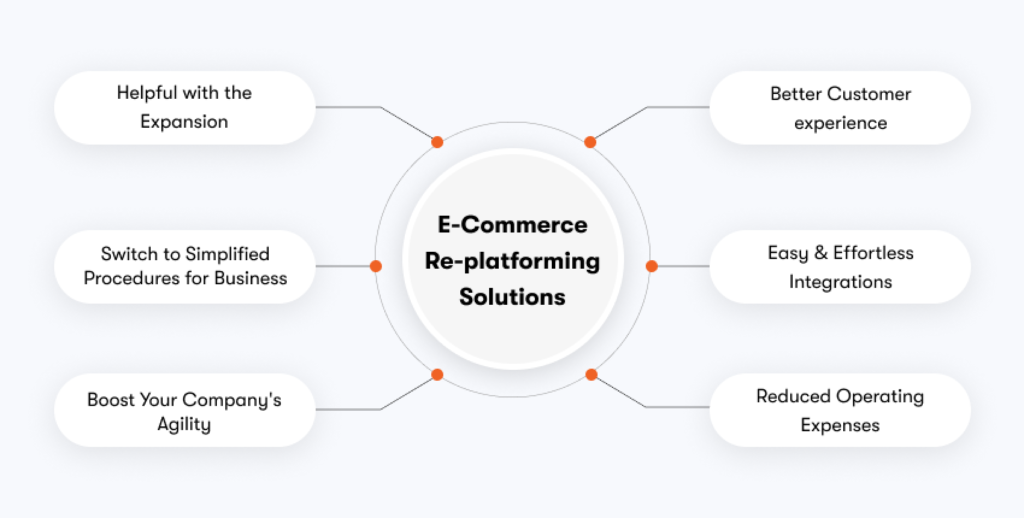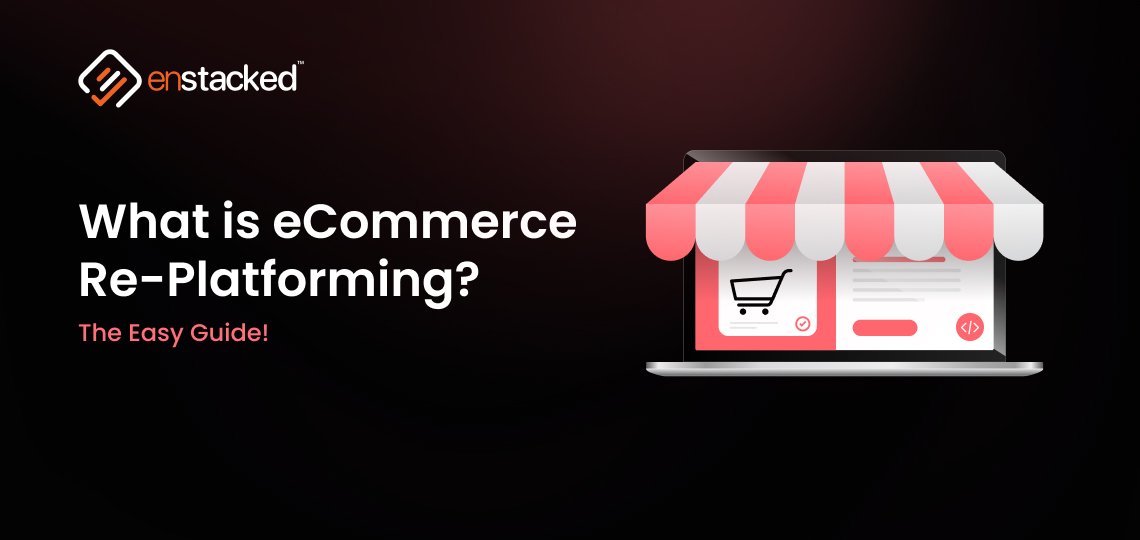Is your e-commerce platform slowing you down? Are you losing out on essential features provided by your rivals? Is the platform you use for eCommerce old? Are you noticing an increase in bounce and card abandonment rates?
If you’re experiencing these issues, it’s probably time for eCommerce re-platforming.
Your company’s and your customers’ needs are likely to change over time. Technology in the e-commerce sector will evolve, and your initial e-commerce platform may become clumsy, outdated, or inefficient. Although it may seem like a difficult task to move your entire store to a new location, there are several advantages to consider.
The e-commerce industry is projected to be valued at an whopping $5.47 trillion by 2027. This means that the internet world will be both more profitable and more competitive than ever before. The only way to stay ahead of the competition and earn constant money is to keep up with trends and adapt accordingly.
In this blog, let’s get started on the basics of eCommerce re-platforming and why it is important.
The Current SaaS Landscape Across the World!
Some of the most typical reasons for initiating an e-commerce migration are:
- Increasing the speed
- Incorporating new features and functionalities that aren't available on the current platform experimenting
- Including extra components in the user experience, like customization or localization to enhance the performance, scalability, and user experience of the online store.

Some of the most typical reasons for initiating an e-commerce migration are:
Reason 1: Helpful with the Expansion
No brand wants to be stuck in the same position for an extended length of time. Everybody desires development. The more important query is, however, is your present e-commerce infrastructure sufficiently prepared to handle the expansion?
Many e-commerce sites housed on subpar platforms lack the flexibility and customization options necessary to cater to a wider range of customers.
Currently, re-platforming your e-commerce to a top platform offers you a plethora of alternatives and resources to experiment with in order to elevate your brand: improve the customer experience, ensure a lightning-fast website, have superior security protection, a rich user interface, and more.
Reason 2: Switch to Simplified Procedures for Business
Speaking of missing features on e-commerce platforms, certain outdated solutions may not provide you with the necessary resources to develop and improve your company’s operations. You can save a ton of time and effort by using an advanced e-commerce platform that has automation and AI features.
Modern solutions could assist you in automating customer message campaigns, enhancing your fulfillment and logistics procedures, or even better tracking client products and orders throughout the buying process.
This has the potential to increase the efficiency of your entire firm. To get the best results, you can hire a professional eCommerce re-platforming consultant for seamless conversion and streamlined operations.
Reason 3: Boost Your Company's Agility
Some older e-commerce solutions still have substantial constraints on how you can expand and modify your store. A more adaptable e-commerce platform could help you become more agile as the fields of online sales and customer support continue to change.
For example, you may switch to a headless commerce system, which enables you to make dynamic adjustments to consumer experiences without disturbing your backend infrastructure. It only takes minutes to implement new tools and sales tactics into your company when you move to an open, adaptable e-commerce platform that supports an infinite number of features and third-party apps.
Reason 4: Better Customer experience.
What guarantees success? It is undoubtedly more than just the products or services. No matter how high-quality your products are. To attract, engage, and retain e-commerce shoppers, brands must do more than just provide outstanding products.
E-commerce re-platforming solutions provides you with cutting-edge capabilities that are essential for establishing a relationship with your clients and fostering the kind of trust that will keep them interested over time.
It helps you launch personalized marketing and begin delivering tailored information to customers throughout their journey, based on their specific behaviors and trends. Make no sacrifices when it comes to customer experience and make them feel important and valued.
Reason 5: Easy & Effortless Integrations
Because of technological advancements, the marketplace today has a plethora of satisfying integrations that can complete tasks more quickly. Does your present e-commerce platform allow you to integrate its core architecture with a wide range of migration alternatives to help you grow?
If not, it’s crucial to opt for eCommerce re-platforming solutions, from its present platform to one that accommodates seamless integrations. Selecting the appropriate platform that can easily interface with a third-party platform will help you sell more, quickly and intelligently. As a result, sales increase, and customers are more satisfied.
Reason 6: Reduced Operating Expenses
There are times when cutting back on legacy infrastructure for your e-commerce company is the greatest approach to save a significant amount of money on running expenses. One way to cut costs for e-commerce business owners is to go from traditional databases to cloud-based technologies. This will reduce the need for servers and hosting fees.
You can even avoid paying for services and tools you don’t need by using an API-based approach to online selling. Without paying for expensive monthly membership costs, you can gain access to all of the essential features your store depends on by simply moving to a new SaaS solution. Even so, you may use automation and artificial intelligence to lower your operational expenses.
Case Study 101
After increasing their income from $300,000 in 2013 to $4.7 million in 2015, David and Andrew Hath, the creators of Bombas, successfully negotiated a contract with Daymond John on Shark Tank. Well, that was good news. The bad news was that their website could no longer support the 4,000 transactions per day it was receiving as a result of its success—it was only handling 500.
In a matter of minutes, product photos crashed, checkout was impossible for customers, and losses reached $15,000. That was all the convincing David needed to switch the Bombas website to Shopify Plus. The process took a long time and cost approximately $150,000, but it was worthwhile.
Bombas and its clients enjoy improved business and customer experiences, and in the first year alone, the move is anticipated to have saved $108,000 in platform expenditures. The team at Bombas saw lost revenue due to unreliable infrastructure as a reason for re-platforming, and the benefits included scalability, innovation, and an almost instantaneous positive return on investment.

The Key Challenges of Re-platforming eCommerce?
Data Migration
- Moving massive volumes of data from the old platform to the new one can be difficult and time-consuming. It's also important to make sure that the data is accurate and intact during this process.
Customization and Flexibility
- Adapting to the new platform to meet your unique business requirements and preserving the desired level of customization and flexibility can be difficult. It's important to select a platform that provides the possibilities for customization.
Integration with Third-Party Systems
- integrating the new platform with third-party systems, like inventory management, payment gateways, and CRM tools, can be difficult. To ensure that these systems communicate with each other smoothly, it's vital to ensure that everything works together.
Compatibility issues
- If the new system doesn't function as planned, the old infrastructure may need more costly updates (rearchitecting) to make it function properly.
Scope creep
- If a plan isn't well-executed, it's easy to keep adding features or changing existing ones, which reduces overall return on investment when cost is taken into account.
Change management
- Users (employees or customers) may require further training or reorientation in order to adjust to a new system. sufficient time and training initiatives can help ease the transition
To Sum it Up!
E-commerce is a growing and incredibly popular industry, but it’s also competitive as well. To survive and thrive in this competitive environment, re-platforming becomes important.
Not to add that e-commerce re-platforming projects can be difficult, time-consuming, and demanding. However, it’s critical to adjust to changing consumer tastes, market trends, and corporate requirements. The future is here, and it’s evolving more quickly. As a brand, you should develop and adapt and re-platforming can make it happen.
But, striking the arrows in the air, thinking it will hit the target will not work. You need to do proper research, choose the right technologies, and curate a roadmap – to make it all work for you.
But, hey don’t get overwhelmed. Partner with leading eCommerce development company like Enstacked. We can understand your unique business needs and guide you to get started on the right path with consultation or can even handle the entire eCommerce re-platforming solutions for you!
Don’t wait much! Book your free consultation with us right away!


